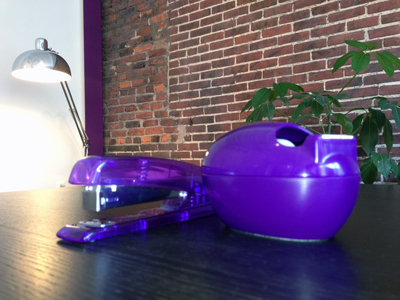by Ken Lopez
Founder/CEO
A2L Consulting
I have seen some great law firm litigation graphics departments over the past 20 years. The best was at Howrey, which is where A2L's second team member and others came from in the mid-1990s. Back then, Howrey's litigation graphics department was led by an Academy Award-winning artist and producer.
These credentials commanded respect. Litigation graphics were largely a mystery to most lawyers at that time, and I believe that the litigators at Howrey were quite proud of the in-house graphics department. Smartly, it and other divisions of Howrey were separate profit centers. The idea was visionary, but it failed. And it failed long before the firm did.
Having been in the industry for 18 years, I have seen many firms, vendors, and law firm graphics departments fail. I see a pattern in those failures and have come to believe that a law firm graphics department can, at best, only achieve short-term success.
Here are 13 reasons why I believe that in-house law firm litigation graphics/trial graphics/animation departments are mostly doomed for failure:
1. Law firms rarely go to trial. By far the biggest thing working against an in-house trial/litigation graphics department is how rarely it is used. Even the largest law firms only make it all the way to trial maybe a dozen times per year, and that is across 15 or more offices. Even if you imagine that every one of those trials was handled by an in-house team, it's just not that much work. Contrast that with our firm, which goes all the way to trial 25 to 75 times per year in addition to a lot of related work. More trials equals more meaningful experience.
2. Litigators don't need graphics; they need advice. In the 1990s, litigators were just adopting visual trial presentations for the first time. Then, most any graphic artist would do, since it was all new anyway. In the 2000s, good artists took courses from Edward Tufte and began to educate litigators on principles of information design. In other words, they began to give advice. In the 2010s, serious litigators rely on sophisticated litigation consulting firms, not an art or multimedia department, to support them at trial. These firms, such as A2L, have integrated Ph.D. social scientists with former litigators and litigation graphics departments so that the advice is drawn from science, data and experience, not only the gut instinct of an artist.
3. Lawyers under pressure can be, well, difficult. The in-house law firm artists I know would basically put litigators into two camps, those that screamed at them and those who didn't. This would be a difficult work environment for anyone, but for an artist it is a recipe for failure.
4. Artists take things personally. We creative types are sensitive. When we make art, we give a piece of ourselves away and put it out there for criticism. If you've done this for as long as I have, criticism is welcomed, but if you are more junior, to criticize the art is to criticize the person.
5. Being a non-lawyer in a law firm is tough enough. We all know it is never easy to be a non-lawyer in a law firm. If the culture is bad at the firm, non-lawyers feel a sense of disdain. This includes the art department.
6. The good ones command more value elsewhere. Increasingly there is a revolving door between law firm staff and outside firms. From trial technicians to e-discovery personnel to litigation support staff, there is a relationship between law firms and outside vendors that is quite similar to the relationship between government and the private sector. You put in your time at the law firm and then you go out to an outside firm to earn more money by selling back to your old firm. We have a number of former big law firm staff on our team.
7. No great artist ever said that he or she hopes to work in a law firm someday. If you are a great artist, you grew up sketching. Some people, on the other hand, picked up some form of creative design later in life, as I did with 3D animation during law school. If you see yourself as an artist, I think it is hard to see yourself at a law firm.
8. Outsourcing everything is de rigueur. We are in an era where it is possible to outsource everything that is not core to your business. Most startups outsource everything now from IT, to creative, to HR. Law firms are a little behind the curve on this one, but they are catching up.
9. The pride and mystery are mostly gone. In the 1990s, when litigation graphics were new, artists were seen as magicians who could conjure up clever ways of explaining simple concepts. Now, that is simply your entry ticket to the game. Unless you can go beyond that, it is hard to be seen as much more than a clever person with some artistic skills.
10. Artists go for stability and find layoffs. Many creative firms suffer from poor management, so many artists leave them to seek stability and a good salary at a major law firm. It makes sense to a degree as not every artist can join Ogilvy & Mather, Pixar or even A2L. However, with the number of staff layoffs at law firms, the best reasons for being at a law firm are not actually there for most people.
11. Everyone needs to grow. In a litigation consulting firm such as ours, we are pushing the boundaries of litigation graphics every day. We are constantly exploring new and interesting ways of telling stories, illustrating points and persuading in the courtroom. This is possible since we have a team that learns from one another. It is rare for a law firm to have more than one real talent on staff. Eventually that is a recipe for stagnation.
12. The best litigators will look outside the firm. Even though Howrey had one of the best in-house litigation graphics departments in history, the firm was still one of our best clients for A2L, and many of their former litigators still are. Why? First, it is hard for an in-house department to be better than even an average litigation consulting firm, and the best litigators know that intuitively and so do trial-savvy in-house counsel. Second, the alpha personality type typical of so many successful litigators does not take well to rules, like being told they must use the in-house department.
 13. The law firm environment is distinctly non-creative. To be creative, you must work in a creative environment. I take this seriously at A2L, and our headquarters office is an open creative space with exposed brick, tin ceilings and a lot of splashes of color. I even insist (although I'm still too often ignored) that everything down to our office supplies "look as if a designer touched it." Yes, that's my stapler and tape dispenser pictured to the right. Why? I believe good creative people see good design everywhere they go. Those who don't, end up not being good creative people.
13. The law firm environment is distinctly non-creative. To be creative, you must work in a creative environment. I take this seriously at A2L, and our headquarters office is an open creative space with exposed brick, tin ceilings and a lot of splashes of color. I even insist (although I'm still too often ignored) that everything down to our office supplies "look as if a designer touched it." Yes, that's my stapler and tape dispenser pictured to the right. Why? I believe good creative people see good design everywhere they go. Those who don't, end up not being good creative people.
In summary, Howrey did it right. They set up their graphics department with a leader you could respect and learn from. They saw their graphics department as a profit center not as overhead. Perhaps some law firm will get this right eventually, but I'm not familiar with one that has.
Law firms have a challenge with outsourced services: they can't make money from them, or can they? I'll cover this topic in an article in the near future.
You might also enjoy these other articles and resources on A2L Consulting's site related to trial presentation, litigation graphics and trial graphics:







Leave a Comment